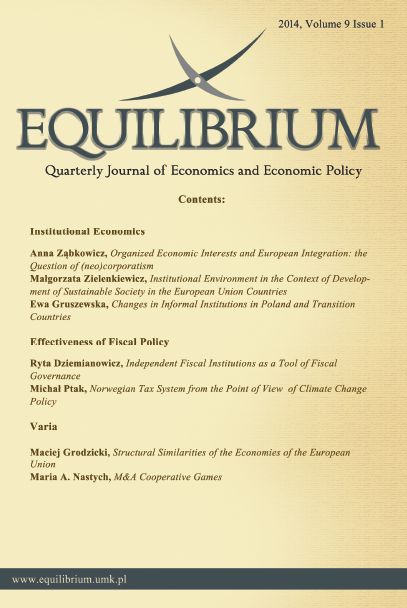Structural Similarities of the Economies of the European Union
DOI:
https://doi.org/10.12775/EQUIL.2014.006Keywords:
economic structure, structural convergence, European integrationAbstract
From the point of view of the consequences of European integration, similarities of economic structures of member states are of high relevance. The main objective of the paper is to analyse how those similarities looked like in the period of 1970-2006 for EU15 and in 1995-2006 for EU25 countries. The analysis consists of two stages and refers to the similarities in employment composition between three sectors of economy, and also between subsectors of manufacturing and services? distinguished on the basis of their technological advancement and knowledge intensity. In the first step, on the basis of the EU-KLEMS database, a measure of structural similarity, Krugman specialization index, was calculated for all pairs of EU countries. Observation of its values points to an ongoing homogenization of EU15 economies and of their manufacturing structures, but also to an increase in differences of knowledge intensity in services. In the broader sample of EU25, despite an ongoing economic transition, no significant homogenization of structures was observable. As the second step, a cluster analysis was conducted, which allowed for identification of development patterns in the sample of European countries.
Downloads
References
Chenery H.B. (1982), Industrialization and Growth: The Experience of Large Countries, ?World Bank Staff Working Papers?, No. 539.
Chenery H.B., Taylor L. (1968), Development Patterns: Among Countries and Over Time, ?The Review of Economics and Statistics?, Vol. 50, No. 4, http://dx.doi.org/10.2307/1926806
Chenery H.B., Watanabe T. (1958), International Comparisons of the Structure of Production, ?Econometrica?, Vol. 26, No. 4, http://dx.doi.org/10.2307/1907514
Clark C. (1951), Conditions of Economic Progress, MacMillan & Co. Ltd, London.
Cornwall J., Cornwall W. (1994), Growth Theory and Economic Structure,?Economica?, Vol. 61, No. 242, http://dx.doi.org/10.2307/2554960
Döhrn R., Heilemann U. (1996), The Chenery hypothesis and structural change in Eastern Europe, ?Economics of Transition?, Vol. 4, Issue 2, http://dx.doi.org/10.1111/j.14680351.1996.tb00180.x
ECB, MPC task force of the ESCB (2004), Sectoral Specialisation in the EU: A Macroeconomic Perspective, ?Occasional Paper Series?, No. 19.
Eurostat (2011). High technology and knowledge-intensive sectors. http://epp.eurostat.ec.europa.eu/cache/ITY_SDDS/Annexes/hrst_st_esms_an9.pdf (02.06.2013).
Heston A., Summers R., Aten B. (2012), Penn World Table Version 7.1, Center for International Comparisons of Production, Income and Prices at the University of Pennsylvania.
Höhenberger N., Schmiedeberg, C. (2008), Structural Convergence of European Countries, ?Center for European, Governance and Economic Development Research Discussion Papers?, No. 75.
Kenessey Z. (1987). The Primary, Secondary, Tertiary and Quaternary Sectors of the Economy, ?Review of Income and Wealth?, Vol. 33, Issue 4, http://dx.doi.org/10.1111/j.14754991.1987.tb00680.x
Kuznets S. (1949), National Income and Industrial Structure, ?Econometrica?, Vol. 17, http://dx.doi.org/10.2307/1907310
Kuznets S. (1980), Driving Forces of Economic Growth: What Can We Learn from History?, ?Weltwirtschaftliches Archiv?, Vol. 116, Issue 3, http://dx.doi.org/10.1007/BF02708815
Landesmann M. (2000), Structural Change in the Transition Economies, 1989 to 1999, ?wiiw Research Reports?, No. 269.
Malerba F. (2002), Sectoral systems of innovation and production, ?Research Policy?, Vol. 31, Issue 2, http://dx.doi.org/10.1016/S0048-7333(01)00139-1
Marelli E. (2004). Evolution of employment structures and regional specialisation in the EU. ?Economic Systems?, Vol. 28, Issue 1, http://dx.doi.org/10.1016/j.ecosys.2004.01.004
Mickiewicz T., Zalewska A. (2005), De-industrialisation and the Post-Communist Transition: Rowthorn and Wells? Model Revisited, ?CSESCE Working Papers?, No. 59.
Molle W. (1997), The Regional Economic Structure of the European Union: an Analysis of Long-Term Developments [in:] Peschel K. (ed.), Regional Growth and Regional Policy Within the Framework of European Integration, Heidelberg: Physica-Verlag, http://dx.doi.org/10.1007/978-3-642-48428-5
Perez C. (1983), Structural Change and Assimilation of New Technologies in the Economic and Social Systems, ?Futures?, Vol. 15, No 5, http://dx.doi.org/10.1016/0016-3287(83)90050-2
Rosenstein-Rodan P.N. (1944), The International Development of Economically Backward Areas, ?International Affairs?, Vol. 20, No. 2, http://dx.doi.org/10.2307/3018093
Rostow W. (1959), The Stages of Economic Growth, ?The Economic History Review?, Vol. 12, No. 1, http://dx.doi.org/10.2307/2591077
Rowthorn R., Ramaswamy R. (1997), Deindustrialization: Causes and Implications, ?IMF Working Paper?, WP/97/42.
Schettkat R., Yokarini L. (2006), The Shift to Services: A Review of the Literature, ?Structural Change and Economic Dynamics?, Vol. 17, Issue 2, http://dx.doi.org/10.1016/j.strueco.2005.04.002
Schumpeter J. (2009), Kapitalizm, socjalizm, demokracja. Wydawnictwo Naukowe PWN, Warsaw, http://dx.doi.org/10.4324/9780203202050
Stephan J. (2002), The Productivity Gap between East and West Europe: What Role for Sectoral Structures during Integration? ?Acta Oeconomica?, Vol. 52, No. 3, http://dx.doi.org/10.1556/AOecon.52.2002.3.1






